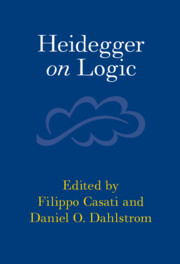Book contents
- Heidegger on Logic
- Heidegger on Logic
- Copyright page
- Contents
- Contributors
- Acknowledgments
- Method of Citation
- Introduction
- Part I Normativity, the Phenomenology of Assertions, and Productive Logic
- Chapter 1 Heidegger’s Phenomenology and the Normativity of Logic
- Chapter 2 Heidegger on the Changeover in Assertions
- Chapter 3 Heidegger’s Productive Logic
- Part II Language, Logic, and Nonsense
- Part III Paradox, the Prospects for Ontology, and Beyond
- Part IV Logical Principles and the Question of Being
- References
- Index
Chapter 2 - Heidegger on the Changeover in Assertions
from Part I - Normativity, the Phenomenology of Assertions, and Productive Logic
Published online by Cambridge University Press: 15 September 2022
- Heidegger on Logic
- Heidegger on Logic
- Copyright page
- Contents
- Contributors
- Acknowledgments
- Method of Citation
- Introduction
- Part I Normativity, the Phenomenology of Assertions, and Productive Logic
- Chapter 1 Heidegger’s Phenomenology and the Normativity of Logic
- Chapter 2 Heidegger on the Changeover in Assertions
- Chapter 3 Heidegger’s Productive Logic
- Part II Language, Logic, and Nonsense
- Part III Paradox, the Prospects for Ontology, and Beyond
- Part IV Logical Principles and the Question of Being
- References
- Index
Summary
This chapter examines the connection between Heidegger’s analysis of assertions and the present-at-hand. It argues that Heidegger does not claim that assertions can only intend present-at-hand entities. Only in limiting cases, after a changeover in our understanding of being, are assertions so constrained. There are both textual and phenomenological grounds for this argument. Phenomenologically it is evident that many assertions are part of circumspective and absorbed dealing with equipment. The textual argument lies in an interpretation of Heidegger’s underdeveloped notions of unthematic understanding and the changeover. The chapter draws on Aron Gurwitsch’s phenomenology of thematic fields and argues that the changeover, in Being and Time, functions like a figure–ground switch. An upshot of the argument is that there is no paradox in Being and Time making assertions about entities that are not present-at-hand. It also explains Heidegger’s careful methodological considerations about how to thematize and grasp these entities phenomenologically.
Keywords
- Type
- Chapter
- Information
- Heidegger on Logic , pp. 34 - 52Publisher: Cambridge University PressPrint publication year: 2022



